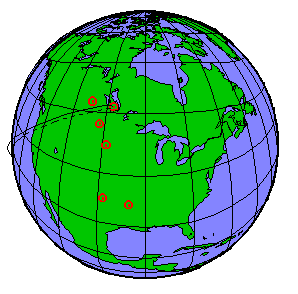 Soyuz
emergency landing zones - the "Ugol Pasadki" story
Soyuz
emergency landing zones - the "Ugol Pasadki" story
Sven Grahn
Contents
First
inkling - Soyuz-33
The Kettering
Group - the group of space observers led by the late Geoff Perry to
which I have belonged since 1966 - first stumbled across the fact
that there were emergency landings points for Soyuz flights in
connection
with the flight of Soyuz-33 This spacecraft carried Nikolai
Rukavishnikov
and Bulgarian Georgi Ivanov (this crew had the call-sign
SATURN (hear it!)) and failed to dock with Salyut-6.
It
took us a long time to figure out this mystery in detail and we did not
publish our findings (1, 2)
until twelve years later! Here is how the story goes:
It started with a note
in
a tracking report for Soyuz-33 that I distributed to the
Kettering
Group:
April
11,
1979: " ...... On the following pass nothing was heard from
PROTON,
but scattered comments could be heard from SATURN for 8.5 minutes from
2210.50 until 2219.15 UT. Geoff [Perry] phoned before the end of the
pass
and I could only tell him that it did not seem as if the docking had
been
done, but they were still talking. Geoff said goodnight from his
telephone
booth in Bude and I finished the pass, rewound the tape and listened.
No
doubt, the SATURN crew could be
heard
saying (click here to listen): "..Vitok 29, ugol
pasadki....,
vitok 30...etc". UGOL PASADKI = Landing angle!!!. This
gave
it all away, at a time when they should be rejoicing over the
successful
docking
the SATURN crew was reading back landing instructions for revs 28,29,20
etc..! ........"
On 11 April 1979, between
0101
and 0105 UT, during rev 5 of Soyuz 33, Mark Severance, then living in
Fort
Worth, recorded a similar transmission from the cosmonauts.
Here is what Mark wrote
in
letter dated 11 May 1979:
"... Good
voice
was also received on [rev] 5 with Ivanov reading a bunch of numbers
about
someting, I thought the turning off of systems (vikluchil), and
mentioning
some sort of angle (ugol),...."
A little further into the
letter
Mark wrote:
".... I
read
Sven's report [my tracking report for Soyuz-33 cited above] and was
very
interested in the crew's (SATURN) reading of landing angles for revs
28,
29, 30 etc. .... I started going over my tapes again and discovered
that
Ivanov's Bulgarian accent (hear
him read the numbers!)had led me astray on my interpretation of
my rev 5 reception. What he was saying in fact was Dvigatel = ENGINE
giving
some numbers, possibly times and Ugol Pasadki = Landing angles for revs
8 through 17 (or 7 through 16). With Sven's tapes in mind I
thought
they might have been planning emergency entries at that time bu the
landing
points for the given Moscow times didn't pan out - one time they were
targeted
for Indianapolis, Indiana! These items must have another meaning but I
don't know what it might be!....."
Mark's interpretation was
absolutely
correct! And it seems that he understood what the "landing angle" meant
- the angular distance from the retrofire point to the landing point.
Indiana
-yes he was so right! Closer analysis of Mark's recording shows that
the
crew reported a "form" [23] of numbers giving the "vitok" (orbit
number),
a time (Standard Moscow Time), and "Ugol Pasadki" (landing angle)
ranging
from 120 to 128 (See table below).
A
question to veteran cosmonaut Vladimir Shatalov
However, we were never
quite
sure what "Ugol Pasadki" meant, so when I told Geoff Perry that veteran
cosmonaut Vladimir Shatalov would
visit my employer, the Swedish Space Corporation, on 8 October 1985
(in connection with the IAF Congress in Stockholm), Geoff told me: "Ask
him about 'Ugol Pasadki'." I must say I never expected an answer when I
told him I had heard this term in air-to-ground voice, but the jovial
cosmonaut
carefully explained that that "Ugol Pasadki" could be considered as the
"argument of retro-fire" - the angle subtended at the Earth's center by
the arc of the orbit between retro-fire and the landing point. This is
how he put it after having thought about it for thirty seconds:
"Each night
before
the crew goes to bed we send them an orbit number and an angle which
tells
them where to fire the retro-engine in order to reach the designated
landing
spot. It is the angle measured along the orbit, subtended at the
Earth's
centre".
More
"Ugol Pasadkis" from Mir....
On 27 May 1988, John Biro,
in
Chelmsford, Massachussetts, USA, sent Max White a transcript of a
series
of numbers transnmitted by Mir by RTTY on the previous day. They were
immediately
recognized a being of the same format as those which Mark Severance had
logged in 1979, with the third column ranging from 120 to 128. On
request,
Biro reviewed earlier tapes and located a similar transmission on 25
January
1988.
.......
and from ASTP
When Geoff Perry described
Biro's
intercepts I recalled that similar data was to be found in the
transcripts
of ASTP (Apollo-Soyuz Test project) air-to-ground voice that I
had
in my possession. One example of such a data set is shown in the table
below. The data comes from "Form 14" and the "impulse" is 071
(presumably
m/s) everywhere and the engine burn is 157 (presumably seconds)
everywhere.
The reason for the difference in "Ugol Pasadki" for the two mission can
probably be related to the fact that the two spacecraft flew at
different
altitude at the time when the landing angles were read.
SOYUZ-33
| Rev |
NBECT |
NBECL |
Time of
retrofire |
"Ugol
Pasadki" |
Landing
Point |
| Nr |
UT |
Deg
(W) |
UT |
Deg |
Lat |
Long
|
|
8
|
0519.2
|
169.8
|
0506.30
|
128
|
49.4 N
|
107.3 W
|
|
9
|
0649.3
|
192.7
|
0641.12
|
128
|
51.8 N
|
102.1 W
|
|
10
|
0819.3
|
215.6
|
0816.07
|
127
|
46.5 N
|
98.7 W
|
|
11
|
0949.3
|
238.5
|
0953.03
|
123
|
33.0 N
|
97.6 W
|
|
12
|
1119.5
|
260.9
|
1102.16
|
125
|
40.4 N
|
137.5 E
|
|
13
|
1249.5
|
283.8
|
1237.98
|
127
|
50.8 N
|
146.0 E
|
|
14
|
1419.5
|
306.7
|
1410.75
|
128
|
51.7 N
|
141.3 E
|
|
15
|
1549.6
|
329.6
|
1544.85
|
127
|
48.6 N
|
140.2 E
|
|
16
|
1719.6
|
352.5
|
1707.15
|
127
|
49.9 N
|
71.9 E
|
|
17
|
1849.6
|
15.4
|
1840.63
|
128
|
51.8 N
|
71.3 E
|
The table above
comes from
Mark Severance's intercept of voice from Soyuz-33 on 121.75 MHz in
April
1979.
The table on the
right comes
from the air-to-ground transcripts from the Apollo-Soyuz Test Project
published
ny NASA.
NBECT =
North-Bound
Equator Crossing Time
NBECL =
North-Bound
Equator Crossing Longitude
The red
numbers are those that were contained in the "Forms" read by the
cosmonauts.
|
SOYUZ-19
| Rev |
NBECT |
NBECL |
Time of
retrofire |
"Ugol
Pasadki" |
Landing
Point |
| Nr |
UT |
Deg (W) |
UT |
Deg |
Lat |
Long
|
|
15
|
1017.8
|
324.9
|
1019.87
|
94
|
50.1 N
|
138.9 E
|
|
16
|
1146.4
|
347.5
|
1141.55
|
90
|
48.0 N
|
68.6 E
|
|
17
|
1315.2
|
10.1
|
1313.32
|
92
|
51.67 N
|
67.4 E
|
|
21
|
1910.9
|
100.6
|
1910.85
|
102
|
50.4 N
|
1.8 E
|
|
22
|
2039.9
|
123.2
|
2026.63
|
100
|
34.7 N
|
93.2 W
|
|
23
|
2208.8
|
145.8
|
2159.47
|
101
|
44.6 N
|
98.9 W
|
|
24
|
2337.7
|
168.5
|
2332.52
|
102
|
51.0 N
|
98.0 W
|
|
25
|
0106.6
|
191.1
|
0104.00
|
102
|
51.8 N
|
104.4 W
|
|
26
|
0235.5
|
213.5
|
0237.35
|
102
|
48.0 N
|
101.1 W
|
|
27
|
0404.4
|
236.4
|
0412.21
|
101
|
35.4 N
|
98.7 W
|
|
28
|
0533.4
|
259.0
|
0521.67
|
100
|
38.7 N
|
136.7 E
|
|
30
|
0831.2
|
304.2
|
0827.63
|
102
|
51.8 N
|
136.4 E
|
|
31
|
1000.1
|
326.9
|
1000.25
|
102
|
50.1 N
|
136.5 E
|
|
32
|
1129.0
|
349.5
|
1121.63
|
101
|
48.1 N
|
67.3 E
|
|
33
|
1257.9
|
12.1
|
1253.86
|
102
|
51.6 N
|
65.6 E
|
|
34
|
1426.8
|
34.7
|
1426.40
|
102
|
50.7 N
|
65.5 E
|
|
35
|
1555.7
|
57.4
|
1553.85
|
102
|
51.6 N
|
34.0 E
|
|
36
|
1724.6
|
80.0
|
1725.97
|
101
|
49.0 N
|
29.0 E
|
|
37
|
1853.4
|
102.6
|
1853.77
|
102
|
49.9 N
|
2.1 E
|
|
The
use of "Ugol Pasadki" in the Soyuz Space Navigation Display
An explanation of the
meaning
of "Ugol Pasadki" can be found in the sketch of the space navigation
display
of early Soyuz craft reproduced below. The position of the spacecraft
is
normally shown by the rotating globe on the left side of the display.
However,
the display can operate in a mode where it shows the landing point if,
at that particular instant" the retro rocket is ignited. To obtain the
landing point from the orbital position the landing angle "Ugol
Pasadki"
is entered in the window in the lower right corner of the display by
rotating
the adjacent knob. When the "Display Mode" knob is moved over to the
landing
site position the globe shows the landing site.
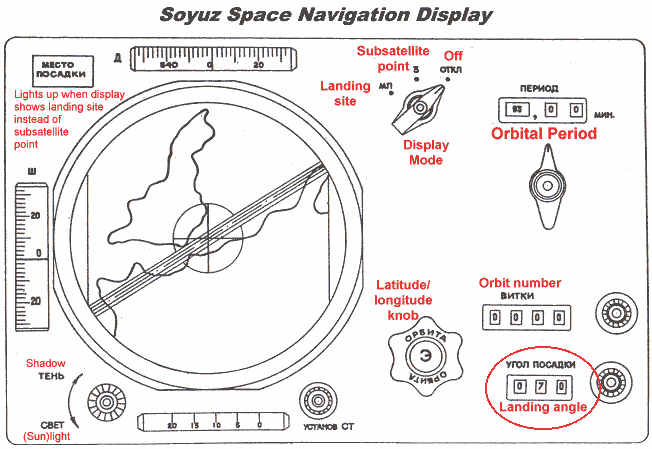
Three
main landing zones
When plotting the data
from
the two tables above on a world map a really interesting pattern
emerges.
There are three emergency landing zones that are common for both
flights
(and for the 1988 Mir data as well); The Sea of Okhotsk, Kazakhstan
near
Baikonur, and the prairies of North America. The North American
prairies
and the steppes of Kazakhstan are similar in terrain type. The use of
the
Sea of Okhotsk is somewhat surprising. One could have imagined that
landing
in the Siberian taiga could have been an alternative, but obviously
ease
of access to the crew after landing is most important.
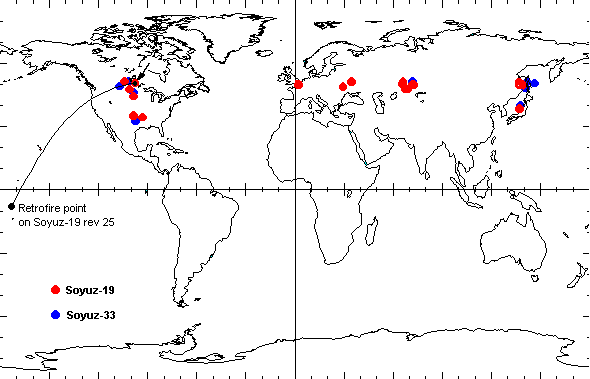
....
including the North American Prairies
If we examine the North
American
recovery points in the map below we see that there are landing oints in
Manitoba, Saskatchewan, North Dakota, Texas and, Oklahoma. The Texas
landing
point for Soyuz-33 at 33N, 97.6 W is actually quite close to Fort Worth
(32.75 N, 97.32 W )where Mark Severance recorded the landing angle data!
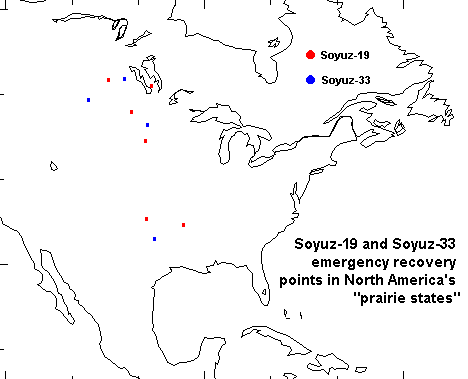
Secondary
(?) sites in France and the Ukraine
The "Western Europe"
recovery
points are not less interesting. Two of the Soyuz-19 reovery points are
in the region called "Plaine des Flandres" on my map or "Picardi"! The
two recovery points for revs 35 and 36 are both in the Ukraine, north
of
Poltava and near Kiev!
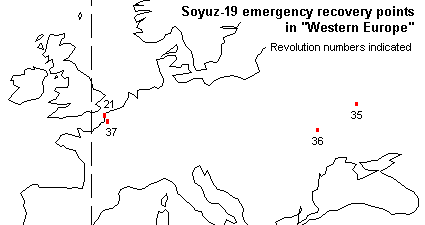
As pointed out in (2)
there is an agreement initiated by the United Nations (3)
which requires that "If, owing to accident, distress, emergency or
unintended
landing, the personnel of a spacecraft land in territory under the
jurisdiction
of a Contracting Party or have been found in the high seas or in any
other
place not under the jurisdiction of any State, they shall be safely and
promptly returned to representatives of the launching authority."
Instructions
in English on the bottom of the capsule
It is clear that the
possibility
of a landing outside the Soviet Union/Russia was taken into account in
the planing of Soyuz/Salyut/Mir flights. The pictures below taken of
the
bottom of the Soyuz re-entry vehicle with plenty of English
instructions
for helping the crew out of the capsule show that a landing outside
Russian
speaking regions were foreseen as a distinct possibility.
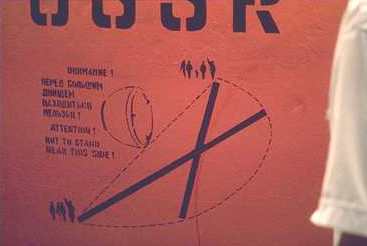
Is this a warning to
stay
away from the area of radiation from the gamma-ray
sources that are used as "transmitters" for the backscatter "altimeter"
that
triggers the
soft-landing
retro-rockets?
|
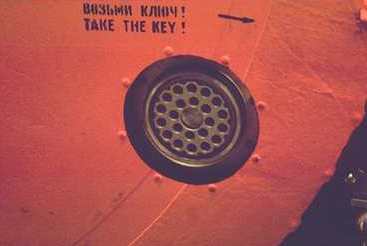
Take the key to open
the
capsule hatch!
|
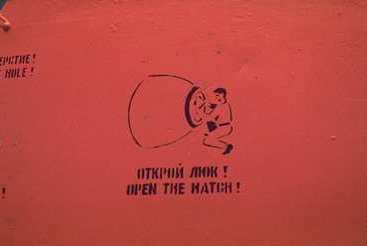
Open the hatch!
|
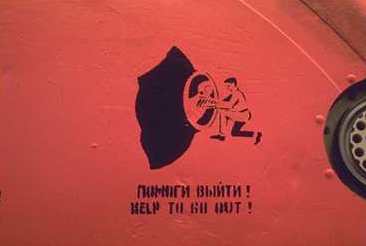
Help [the crew] to
go out!
|
The
Future
It would be instructive to
know
if these emergency landing sites are still in use for Mir and if
they are considered for the International Space Station where the Soyuz
is initially intended to fill the function of emergency crew return
vehicle.
References
-
"Soviet
Cosmonauts
Plan Daily For U.S. Emergency Landings", Aviation Week & Space
Technology,
22 July 1991
-
Perry,
Geoff, "A Kettering Miscellany", The Proceedings of the Sixth
AMSAT-UK
Colloquium, 25-28 July, 1991
-
Agreement
on the Rescue of Astronauts, the Return of Astronauts and the Return of
Objects launched into Outer Space, Article 4, United nations. Entered
into
force on 3 December 1968.

 Back
to Space History Notes
Back
to Space History Notes
 Back
to Space Tracking Notes
Back
to Space Tracking Notes
 Soyuz
emergency landing zones - the "Ugol Pasadki" story
Soyuz
emergency landing zones - the "Ugol Pasadki" story Soyuz
emergency landing zones - the "Ugol Pasadki" story
Soyuz
emergency landing zones - the "Ugol Pasadki" story






